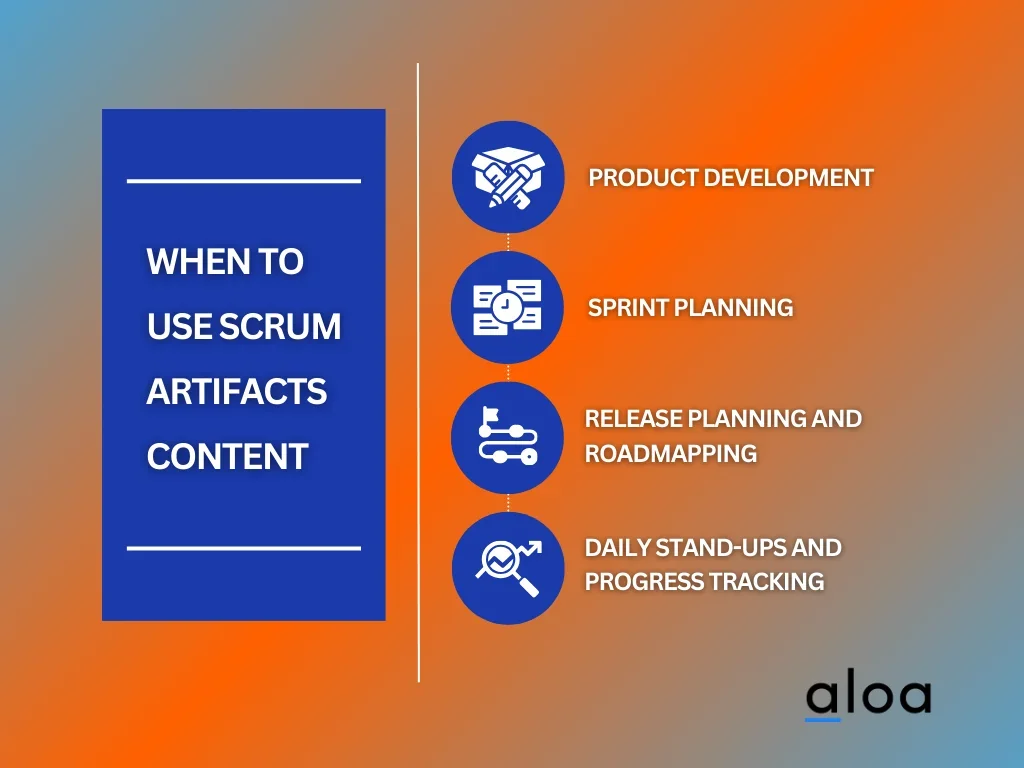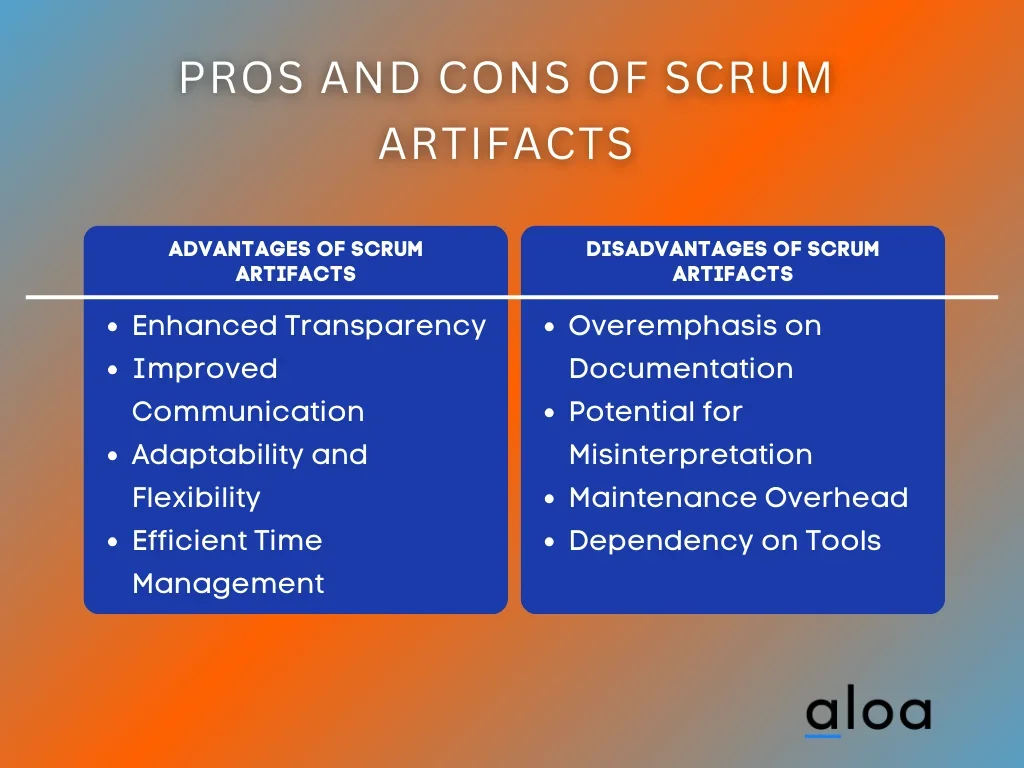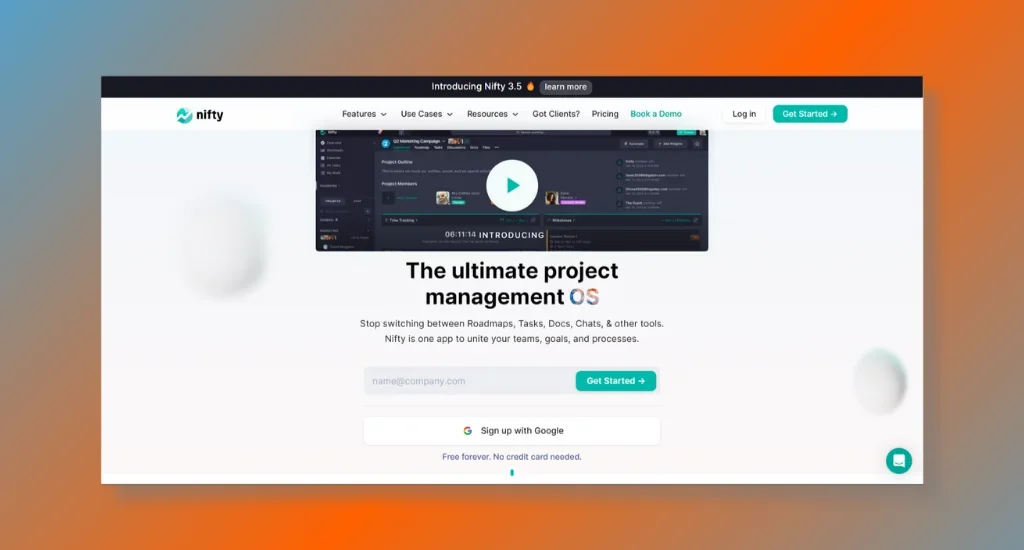Scrum artifacts are pivotal in steering businesses and startups through their software and product development ventures. They facilitate transparent communication, assist in tracking development progress, and foster collaboration among team members throughout planning, execution, review, and adaptation cycles. Embracing Scrum artifacts empowers your team and steers your project towards excellence, enhancing efficiency and ensuring success.
Aloa, a software outsourcing expert, understands the significant role of Scrum artifacts in successful projects, mainly if you're aiming for efficiency and clarity in your development process. Our extensive experience collaborating with startups and enterprises taught us the crucial nature of these artifacts, demonstrating their ability to maintain transparency, foster collaboration, and ensure adaptability throughout project lifecycles.
In this blog, we'll explore Scrum artifacts: what they are, how they help track development progress, and when and how to use them in various situations. We aim to simplify this process by breaking down the essential components of these artifacts and explaining how they function. Plus, we'll dive into real-life examples to show how they're applied in practice.
By the end, you'll have a thorough understanding of Scrum artifacts and a clear insight into how they can significantly improve your project management efficiency and drive successful outcomes in 2023.
Let’s jump in!
What are Scrum Artifacts?
Scrum artifacts are vital elements within the framework, acting as repositories and tools for planning, tracking, and team communication in Agile development. They provide a structured approach to product management, offering a clear roadmap that aligns development with business objectives.
Types of Scrum Artifacts
Scrum artifacts encompass a set of pivotal elements within the Scrum methodology, offering essential insights into the product under development, the planned activities, and the completed tasks within a project. These artifacts are essential within the Scrum framework, encompassing vital components categorized into primary and secondary types:

Primary Types of Scrum Artifacts
Within the Scrum framework, three main Scrum artifacts play a central role in steering the project forward. These most important Scrum artifacts include:
- Product Backlog: It's a prioritized list of all the tasks or features needed for a project. This list changes as the project progresses and new requirements come up.
- Sprint Backlog: This is a subset of items from the Product Backlog chosen for a specific sprint, usually a short work period. It's like a to-do list for that sprint and contains all the tasks needed to achieve its goal.
- Increment: The Increment is what you get at the end of a sprint. It's the sum of all the tasks completed during that sprint from the Product Backlog. Troadmapdhis sum forms a part of the overall product and can be shipped because it adds new functionality.
Secondary Types of Scrum Artifacts
Beyond the main types, other significant Scrum artifacts encompass various elements crucial for effective project management, including:
- Burndown Chart: It's a visual graph that displays the amount of work remaining throughout a sprint. It tracks how quickly tasks are being completed compared to the time available in the sprint.
- Release Burndown: Similar to the Burndown Chart, but instead of tracking work within one sprint, it monitors progress across multiple sprints toward a bigger release goal. It helps gauge how much work is left before the release is ready.
- Definition of Done (DoD): It outlines the specific criteria or conditions that a task from the Product Backlog must meet to be considered complete.
Common Reasons to Invest in Scrum Artifacts
Investing in Scrum artifacts fosters efficient project management within Agile frameworks. These artifacts are essential for facilitating seamless communication and providing invaluable insights and direction for project progress. There are several compelling reasons why organizations should invest time and resources in cultivating and leveraging these artifacts:
- Transparency: Artifacts offer visibility into project progress, fostering understanding and alignment among team members and stakeholders.
- Decision-making: They provide data-driven insights for decision-making during planning and project execution.
- Collaboration: Artifacts encourage collaboration, serving as focal points for discussions and ensuring everyone is on the same page regarding goals and priorities. This shared understanding is vital, particularly for remote teams.
- Progress Tracking: Consistently tracking the progress of work aids in maintaining clarity, assessing performance, and forecasting future developments for the whole Scrum team.
- Issue Identification: Regular updates to artifacts help identify and resolve issues or discrepancies within the project.
- Documentation: They serve as a documented record of project evolution, aiding future reference and learning from past experiences.
How to Implement Scrum Artifacts in Tracking Development Progress
Implementing Scrum artifacts effectively for tracking development progress is pivotal in ensuring clarity, transparency, and alignment within Agile teams. To simplify this process, it's essential to follow a structured approach and adhere to specific vital steps:
Step 1: Establish Clear Artifacts
First, ensure a clear definition and maintenance of the product and sprint backlogs. The product backlog should encompass all features, enhancements, or fixes, prioritized based on business value. Populate the sprint backlog with specific tasks committed to for the current sprint.
Establishing clear artifacts within the Scrum framework is foundational for effective project management. Early establishment and regular reviews of these artifacts enable adaptation to changes, enhancing operational efficiencies and keeping the project aligned with market demands.
Step 2: Regularly Update Backlogs
Next, prioritize consistent updates to the backlogs. Evolve the product backlog to reflect changing requirements and update the Sprint Backlog daily to track progress and remaining work.
Regularly updating these backlogs is vital for maintaining efficiency and steering the team towards objectives. In daily stand-ups or sprint planning meetings, updates help spot and solve potential roadblocks early, fostering successful agile software development through Scrum artifacts.
Step 3: Visualize Progress
Once regular backlog updates for each Scrum project are done, utilize visual aids like burndown charts to depict progress. Create charts visually showcase work remaining versus time, clearly indicating sprint completion status. These charts display work remaining versus time, clearly indicating sprint completion status.
Visualizing progress through these charts fosters transparency and accountability within Agile development. These visualizations facilitate the early identification of roadblocks and areas for improvement, enhancing decision-making and operational efficiency by leveraging the strengths of Scrum artifacts.
Step 4: Conduct Regular Reviews
After visualizing progress, schedule regular reviews. Host sprint reviews to demonstrate the increment and gather feedback. Additionally, refine the product backlog regularly based on new insights and changing priorities.
This ensures necessary adjustments and alignment with the product vision. These iterative and collaborative reviews involve the entire team, promoting transparency and addressing operational inefficiencies effectively. These reviews, conducted at intervals based on the project timeline, drive collaboration and continuous improvement in software development.
Step 5: Promote Collaboration and Transparency
Following regular artifact reviews, promote collaboration among team members and stakeholders. Ensure accessible, updated artifacts and foster understanding of everyone's role in achieving sprint goals. Promote teamwork and transparency among team members and stakeholders.
Encouraging collaboration between Scrum team members ensures transparency and early issue identification among team members and stakeholders. This transparency updates stakeholders on real-time progress, delays, and impediments, nurturing trust and preventing misunderstandings.
Step 6: Encourage Continuous Improvement
Lastly, cultivate a culture of continuous improvement, utilizing artifacts as a foundation for retrospectives. Promote reflection on successes, areas to enhance, and strategies for better future sprints. Foster a culture of continuous improvement, using artifacts as the basis for retrospectives.
Continuous improvement is crucial in Scrum, empowering teams to enhance areas and make changes. Retrospective meetings are invaluable for assessing performance and finding opportunities for advancement. Regular retrospectives refine Scrum processes, aiding development progress and tracking team performance.
When to Use Scrum Artifacts?
Scrum artifacts are versatile in Agile, organizing work, fostering collaboration, and ensuring transparency. They make project information accessible, aiding effective communication and informed decision-making. Common use cases showcase similarities, differences, features, and uses in various scenarios.

Product Development vs. Scrum Artifacts
Product development covers the entire lifecycle of a product, emphasizing its evolution and creation. Conversely, Scrum artifacts, like the product backlog, are evolving repositories that capture and prioritize product requirements. They dynamically represent the product's evolving needs, refining its features, enhancements, and fixes.
For instance, when conceptualizing a new software application, the product backlog is a repository for all envisioned features. As the product evolves, this artifact captures changing user requirements, ensuring the software meets user needs.
Sprint Planning and Execution vs. Scrum Artifacts
Sprint planning and execution in Scrum involve planning and executing tasks within set timeframes. Scrum artifacts, notably the sprint backlog, provide detailed plans for task execution, guiding committed tasks for successful completion within the Sprint.
For example, the sprint backlog in a software development team outlines specific coding, testing, and design tasks allocated to each team member. This artifact ensures alignment with the sprint goals throughout the sprint, facilitating effective task execution and completion.
Release Planning and Roadmapping vs. Scrum Artifacts
Release planning and road mapping encompass strategizing the sequence and scheduling of product feature releases. Scrum artifacts, especially the product backlog, aid by prioritizing items. Release planning aims at future product launches, while Scrum artifacts help arrange development orders and align features for potential upcoming releases.
Consider a product launch for an e-commerce platform; the Product Backlog helps prioritize features critical for the initial release, ensuring the platform's core functionalities are available to users upon launch.
Daily Stand-ups and Progress Tracking vs. Scrum Artifacts
Daily stand-ups and progress tracking involve routine meetings for updates and issue identification. In contrast, sprint backlogs are used as references during these meetings, aiding progress tracking and issue identification. While stand-ups encourage active communication, Scrum artifacts act as informative tools, fostering efficient discussions and issue resolution.
For instance, in a marketing team's daily stand-up, the sprint backlog visualizes ongoing tasks for each campaign, aiding in identifying any impediments affecting progress and facilitating quick resolutions. This shared understanding of the work through progress tracking enhances collaboration among Scrum team members.
Pros and Cons of Scrum Artifacts
Like any concept, Scrum artifacts have both advantages and disadvantages. Before deciding on the appropriateness of this approach and the specific practices to adopt, it's essential to weigh the pros and cons carefully.

Advantages Of Scrum Artifacts
Utilizing Agile Scrum artifacts contributes to coordinating a cohesive team effort. Their structured nature aligns everyone's goals, making them highly advantageous for fostering a shared understanding of project scope and progress. For a comprehensive understanding, let's take a deep dive into some of the advantages:
Enhanced Transparency
Scrum artifacts like backlog and burndown charts offer visibility into project progress, fostering transparency among team members. Scrum emphasizes the transparency of key information, ensuring remote teams are on the same page.
Improved Communication
These artifacts facilitate clearer communication, ensuring everyone is on the same page regarding tasks, priorities, and project goals.
Adaptability and Flexibility
They allow for adaptability, enabling teams to respond promptly to changes and refine strategies throughout development.
Efficient Time Management
Scrum artifacts help manage time effectively by organizing tasks and timelines, aiding in meeting sprint goals.
Disadvantages Of Scrum Artifacts
However, while utilizing Scrum artifacts can enhance collaboration and understanding, they pose particular challenges. Here are some disadvantages to consider:
Overemphasis on Documentation
Excessive focus on artifacts might lead to a culture where documentation becomes more important than actual work progress.
Potential for Misinterpretation
Misunderstanding or misinterpretation of artifacts can occur, leading to confusion or misguided decisions within the team.
Maintenance Overhead
Keeping artifacts updated requires time and effort, potentially diverting attention from actual development tasks.
Dependency on Tools
Reliance on specific tools to manage artifacts can create dependency issues if the tools malfunction or become inaccessible.
Software Options with Scrum Artifacts to Enhance Development Progress
Looking for options with Scrum artifacts to enhance development progress is an excellent step in optimizing your team's efficiency and project management. To explore further, here are two sites for Scrum services, simplifying your approach to streamlined workflows, enhanced collaboration, and maximized productivity within your development endeavors.
1. Atlassian - Aiding Teams in Handling Scrum Artifacts Efficiently

Atlassian's suite integrates Jira Work Management, Confluence, Trello, and Atlas, enabling efficient project management, team collaboration, knowledge-sharing, and goal-tracking. With specific tools like Jira Work Management and Confluence they facilitate streamlined project management for business teams and offer a connected workspace for unified collaboration.
They empower teams to manage large-scale initiatives, brainstorm effectively, share knowledge across teams, and stay aligned with automated workflows. Clients benefit from comprehensive tools tailored for various aspects of work, fostering efficient project management and seamless collaboration.
Notable Features of Working with Atlassian
- Unified Workspace: The platform provides a connected workspace across tools like Jira Work Management and Confluence, ensuring seamless access and collaboration on scrum artifacts.
- Collaboration Tools: They enable effective team collaboration, fostering brainstorming and organizing tasks related to scrum artifacts.
- Knowledge Sharing: Teams can create and share content across the organization, benefiting the documentation of scrum artifacts.
- Automated Workflows: Integration of Jira Work Management facilitates automation, ensuring alignment and tracking the progress of scrum artifacts efficiently.
Atlassian’s Pricing Plans
For precise and updated details on Atlassian's current pricing plans, visit their official website or contact their sales team directly. They have tailored pricing options for businesses requiring collaboration tools, project management, and coordination of scrum artifacts.
Atlassian caters to a wide range of industries and company sizes, including tech startups, medium-sized enterprises, companies, and various sectors like IT, software development, healthcare, finance, and more. Clients benefit from flexible plans catering to diverse business needs, including managing and tracking scrum artifacts.
2. Nifty Project Manager - Facilitating Efficient Handling of Scrum Artifacts

Nifty specializes in agile project management, empowering engineering teams to achieve better results efficiently. Their flexible approach aids in handling scrum artifacts effectively, allowing teams to streamline processes and enhance productivity.
They offer features like balancing resources through task weight assignments using story points, real-time reporting to track automated sprint progress, and centralized product planning, linking pre-planning with user feedback. Clients benefit from a unified platform that simplifies artifact management, enhances collaboration, and provides actionable insights.
Notable Features of Working with Nifty Project Manager
- Balancing Resources: Assign task weights using story points to manage resource allocation effectively.
- Real-time Reporting: Track automated sprint progress in real-time, aiding in artifact visibility and project assessment.
- Agile Sprint Management: Define goal-oriented sprints as milestones for organized project objectives.
- Automated Workflows: Automate task assignments and customize workflows using Kanban, List, and Swimlane views, ensuring seamless artifact management.
Nifty Project Manager’s Pricing Plans
To explore Nifty's pricing plans, visit their website and navigate to the Pricing section tab. There, you'll find detailed information about their various plans, including free options and tiers tailored for teams of varying sizes and needs.
They cater to various industries, including accounting firms, internet marketers, client management organizations, and digital agencies. These businesses benefit from Nifty's diverse plans that suit their specific needs, enabling effective management of scrum artifacts within their project workflows.
Key Takeaway
Scrum artifacts are essential elements in the Scrum framework. They provide tangible and visible representations of the work being done. By guiding the planning, execution, and review of tasks and progress, they empower businesses and startups to achieve transparency, collaboration, and adaptability, fostering efficient and effective development cycles.
Tracking development progress through these artifacts is vital to effectively harnessing their potential. This approach involves monitoring and measuring milestones, creating a roadmap that steers your project towards concrete achievements.
Don't hesitate to contact us at [email protected] for collaborative efforts in optimizing your project management. We aim to streamline processes, enhance your productivity, and clarify workflow. Let's work closely together to turn your goals into reality. Get in touch now, and let's start transforming your approach to project management in 2024.

